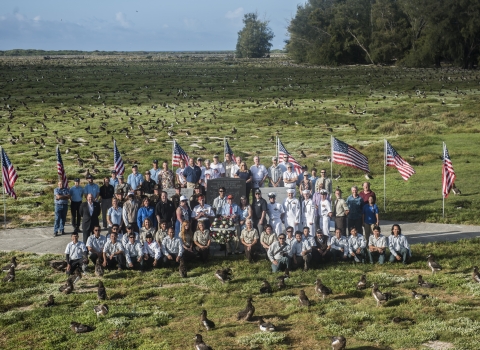“We’re standing on the cusp of unprecedented opportunity with increased availability of state and federal conservation funds and very high interest from landowners to partner with us on conservation projects. The club’s generous and thoughtful donation will fill a critical staffing gap and project backlog that other funding cannot address,” stated Neil Powers, manager of the Fergus Falls Wetland Management District.
The U.S. Fish and Wildlife Service, which manages the district, plans to match the donated funds one-to-one or greater with other conservation partner organizations. They will hire a biologist for three years to help coordinate and implement on-the-ground work starting this spring.
“The direct benefit is going to be putting more wildlife habitat back on the landscape. By doing so that will provide people with a diverse opportunity to enjoy the outdoors while improving water quality and reducing soil erosion,” Powers said. “Further gains include diversifying the economics of the county through grass-based agriculture, creating a conservation connection with working lands so private landowners gain improved grazing land that also aids wildlife.”
“We wanted to invest this money through hiring somebody. That’s the thought process, invest in the future not just on public land but on private land. That’s going to impact our future generations,” said Tony Rondeau, vice-president of the Fergus Falls Fish and Game Club. “There’s a minimal amount of land in public ownership, and if it weren’t for private habitat protecting clean air, clean water, and wildlife, and people dedicated to protecting them, our work would not go anywhere,” Rondeau explained.
The Fergus Falls Fish and Game Club clearly takes a wholistic approach in using funds it receives as donations. “We don’t just take your dollars and spend them. We find ways to match them, make it go farther. We’ve used lots of avenues to do that. It’s exciting to me to see that the club continues with this legacy. It’s been going on for generations, and it continues.”
Rondeau is referring to the club’s proven track record in effective conservation work, tapping into partners and using dynamic approaches over their first century. There’s been a close relationship with the Minnesota Department of Natural Resources since the very beginning and a connection with the U.S. Fish and Wildlife Service since the late 1950s. Over the years, members stocked fish, raised and released waterfowl, sponsored firearms safety classes, built and distributed wood duck and mallard hen houses, and much more.
The club inherited some aspects of its comprehensive approach in 1982 when it absorbed the Save the Wetlands Club, which owned properties. “That attitude has carried over. It’s so special,” Rondeau said. The majority of this work occurs “behind-the-scenes with forethought and dedication to make it work.”
Just one of many hallmark successes is the club’s role in building support for the establishment of the Prairie Wetlands Learning Center. In the mid-1970s, club members Dick Anderson and Roger Rustad provided environmental education outreach to local schools and kept building upon that until 1998 when the center opened, what amounted to a 20-year process of proposals, counter proposals, and fundraising campaigns. “Everyone involved with it was tenacious enough to stay with it to make it work. The City of Fergus Falls, the U.S. Fish and Wildlife Service, Fish and Game Club, many people. The State of Minnesota with Bob Anderson working in concert with everyone to help make it happen,” Rondeau said.
The club has more recently been instrumental in acquiring a tract of land south of the Prairie Wetlands Learning Center and selling it to the U.S. Fish and Wildlife Service as an addition to the property that will enhance youth education opportunities for the nearly 60,000 students who visit the facility annually. They now coordinate an annual week-long Woodie Camp for youth aged 13-15 and partner with Mike Frisch’s School of Fish angling classes.
Ongoing through this whole progression was habitat management development and acquisition of club lands, partnering with the U.S. Fish and Wildlife Service and Minnesota Department of Natural Resources in obtaining grants, developing not just on fee-title lands owned by the club but also on private easement areas. Over 1,200 acres of club lands on 11 properties are open to the public to enjoy for recreation including hunting, hiking and wildlife observation.
According to member Chuck Vukonich, the Fergus Falls Fish and Game Club is likely the oldest active sporting club in Minnesota. Its formation “heralded an era of industrious wildlife related projects and convincing conservation ethic that lives and thrives today.” In 1920, conservation was an idea supported by only a few far-sighted individuals. The need and ability of the club to help fulfill the current unparalleled interest in habitat conservation is proof today of its long-term visionary effectiveness and success.


